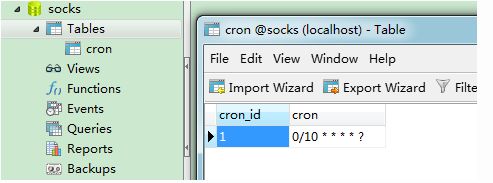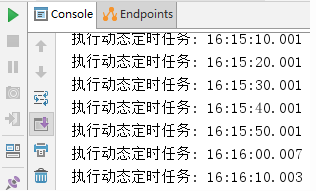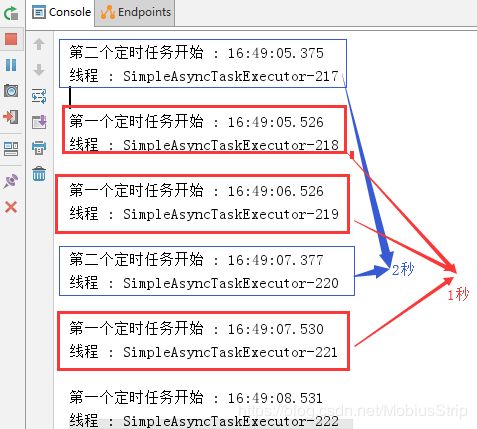前记: 之前看xxl-job源码的时候,看xxl的定时任务处理很微妙,不仅仅用了大小线程池,还用了netty手写了一个rpc框架作为模块之间的调用现在看动态的加载定时任务的cron表达式挺好的,
唯一不足的是还可以优化,将第一次查询的数据加入缓存,每次去查的时候需要手动的去控制cron表达式,并将表达式入库,清除缓存并且重新加载。
记住:提高效率就要用缓存,用了自身或者外部缓存就必须考虑缓存的大小(数据量),避免系统数据量过大而导致内存不足。
使用SpringBoot创建定时任务非常简单,目前主要有以下三种创建方式:
- 一、基于注解(@Scheduled)
- 二、基于接口(SchedulingConfigurer) 前者相信大家都很熟悉,但是实际使用中我们往往想从数据库中读取指定时间来动态执行定时任务,这时候基于接口的定时任务就派上用场了。
- 三、基于注解设定多线程定时任务
-
一、静态:基于注解
基于注解@Scheduled默认为单线程,开启多个任务时,任务的执行时机会受上一个任务执行时间的影响。
1、创建定时器
使用SpringBoot基于注解来创建定时任务非常简单,只需几行代码便可完成:
-
@Configuration //1.主要用于标记配置类,兼备Component的效果。 @EnableScheduling // 2.开启定时任务 public class SaticScheduleTask { //3.添加定时任务 @Scheduled(cron = "0/5 * * * * ?") //或直接指定时间间隔,例如:5秒 //@Scheduled(fixedRate=5000) private void configureTasks() { System.err.println("执行静态定时任务时间: " + LocalDateTime.now()); } }
Cron表达式参数分别表示:
- 秒(0~59) 例如0/5表示每5秒
- 分(0~59)
- 时(0~23)
- 日(0~31)的某天,需计算
- 月(0~11)
- 周几( 可填1-7 或 SUN/MON/TUE/WED/THU/FRI/SAT)
@Scheduled:除了支持灵活的参数表达式cron之外,还支持简单的延时操作,例如 fixedDelay ,fixedRate 填写相应的毫秒数即可。
二、动态:基于接口
基于接口(SchedulingConfigurer)
1、导入依赖包:
org.springframework.boot spring-boot-starter 2.0.4.RELEASE org.springframework.boot spring-boot-starter-web mysql mysql-connector-java org.mybatis.spring.boot mybatis-spring-boot-starter 1.3.1 org.mybatis mybatis 3.4.5 compile
2、添加数据库记录:
开启本地数据库mysql,随便打开查询窗口,然后执行脚本内容,如下:
DROP DATABASE IF EXISTS `socks`;
CREATE DATABASE `socks`;
USE `SOCKS`;
DROP TABLE IF EXISTS `cron`;
CREATE TABLE `cron` (
`cron_id` varchar(30) NOT NULL PRIMARY KEY,
`cron` varchar(30) NOT NULL
);
INSERT INTO `cron` VALUES ('1', '0/5 * * * * ?');
然后在项目中的application.yml 添加数据源:
spring: datasource: url: jdbc:mysql://localhost:3306/socks username: root password: 123456
@Configuration //1.主要用于标记配置类,兼备Component的效果。 @EnableScheduling // 2.开启定时任务 public class DynamicScheduleTask implements SchedulingConfigurer { @Mapper public interface CronMapper { @Select("select cron from cron limit 1") public String getCron(); } @Autowired //注入mapper @SuppressWarnings("all") CronMapper cronMapper; /** * 执行定时任务. */ @Override public void configureTasks(ScheduledTaskRegistrar taskRegistrar) { taskRegistrar.addTriggerTask( //1.添加任务内容(Runnable) () -> System.out.println("执行动态定时任务: " + LocalDateTime.now().toLocalTime()), //2.设置执行周期(Trigger) triggerContext -> { //2.1 从数据库获取执行周期 String cron = cronMapper.getCron(); //2.2 合法性校验. if (StringUtils.isEmpty(cron)) { // Omitted Code .. } //2.3 返回执行周期(Date) return new CronTrigger(cron).nextExecutionTime(triggerContext); } ); } }
4、启动测试
启动应用后,查看控制台,打印时间是我们预期的每10秒一次:
然后打开Navicat ,将执行周期修改为每6秒执行一次,如图: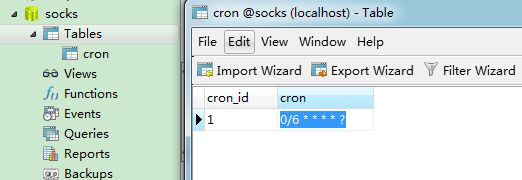
查看控制台,发现执行周期已经改变,并且不需要我们重启应用,十分方便。如图: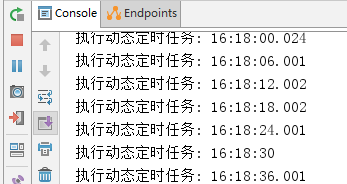
注意: 如果在数据库修改时格式出现错误,则定时任务会停止,即使重新修改正确;此时只能重新启动项目才能恢复。
三、多线程定时任务
基于注解设定多线程定时任务
1、创建多线程定时任务
//@Component注解用于对那些比较中立的类进行注释; //相对与在持久层、业务层和控制层分别采用 @Repository、@Service 和 @Controller 对分层中的类进行注释 @Component @EnableScheduling // 1.开启定时任务 @EnableAsync // 2.开启多线程 public class MultithreadScheduleTask { @Async @Scheduled(fixedDelay = 1000) //间隔1秒 public void first() throws InterruptedException { System.out.println("第一个定时任务开始 : " + LocalDateTime.now().toLocalTime() + "\r\n线程 : " + Thread.currentThread().getName()); System.out.println(); Thread.sleep(1000 * 10); } @Async @Scheduled(fixedDelay = 2000) public void second() { System.out.println("第二个定时任务开始 : " + LocalDateTime.now().toLocalTime() + "\r\n线程 : " + Thread.currentThread().getName()); System.out.println(); } }
注: 这里的@Async注解很关键
2、启动测试
注意:转 https://www.mmzsblog.cn/articles/2019/08/08/1565247960802.html
